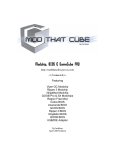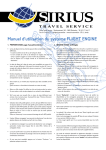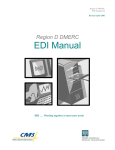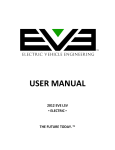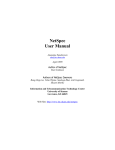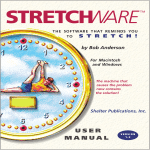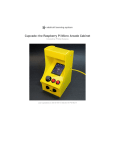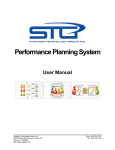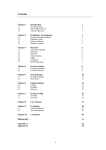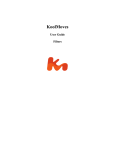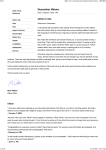Download Possible Projects
Transcript
1 - Medical Claim EDI to PDF translator
Stakeholder: Prof. Tony Baxter/CorrectCare
Context: Medical Claims Processing
High-level Description: Build a system to convert medical forms encoded using ANSI X12 ("an
electronic data interchange") into an industry-standard paper format for humans to view and/or
print.
Details: Most medical claims are generated and submitted electronically using the X12 EDI
format. This is great for reducing transcription errors but is very difficult to troubleshoot when
things do go wrong. There exist industry standard paper forms, with which all claims processors
are familiar. The ability to translate X12 claims into PDF for these standard forms (called UB-04
and HCFA-1500) would be a powerful first-stage troubleshooting tool. It could also be useful for
presenting claim information to patients.
This project would involve learning about the ANSI X12 EDI standard and producing a
translation system. The ANSI X12 formats are described using a finite state machine, which
could be the basis for a lexical analyzer and parser.
Additional Information:
•
•
•
•
•
Description from Dr. Baxter.
X12 Web Site
UB 04 Form Example
National Uniform Billing Committee
HCFA-1500 Example
2 - Medicaid Repricer
Stakeholder: Prof. Tony Baxter/CorrectCare
Context: Medical Claims Processing
High-level Description: Build a system for adjusting medical claim costs for standard services
to normal rates for the region.
Details: It is common for states to tie their medical reimbursements for medical claims for
inmates to Medicaid accepted values. Usually, this is something like a percentage (e.g., 120% or
130%) of regionally accepted rates. A physician or hospital (the provider) will submit a claim
and it is repriced to the appropriate rate. As a contractor to the Ohio Department of
Rehabilitation and Correction (ODRC), CorrectCare performs this repricing service. The current
3M software used to reprice these medical claims is geared towards hospital use and works well
if used for a specific hospital. It does not integrate well into CorrectCare's workflow, where they
provide services for a large number of different hospitals. They need software that easily
switches between hospitals and retains the values from previously repriced claims. Merely
revising the existing software is not an option as it was commercially purchased. The code is
proprietary, and the source code is unavailable.
The project would involve some database design and implementation, a small amount of
reporting, and analysis and implementation of Medicaid pricing. Additional Information
•
Dr. Baxter's Description
3 – ideas for new games for the Herald-leader and/or revising item 4 below (basketball game)
I still have several ideas for this project and its offspring.
I took CS499 in the Spring and the Herald-Leader wanted a series of games to
coincide with relevant calendar events. They wanted a horse racing game for
Derby week, a basketball game for March Madness, and a golf game for the
tournament event at Valhalla.
We quickly produced the basketball game and delivered it during Spring break.
This did not leave time to produce another quality game, so we spent the
remainder of the semester building a PHP/MySQL framework for tracking high
scores. The high score system was built to be expandable so that follow-on
games could use the same architecture. Looking at our game tonight on
kentucky.com, I see they never implemented the high score system.
We also gave them a football game to use in the following Fall semester,
since it was easy to replace the background and ball. The intention was to
buy some time for future classes. Fall semesters would then develop for
Spring calendar events and Spring semesters would develop for Fall events.
I believe the high score system could be developed into a useful marketing
tool. I think players would be more likely to return to the site if their
ego and vanity drives them to achieve high scores. I think the high score
system could also be expanded into a large list of users, aka customers. I
think an opportunity for targeted marketing could be developed from list. We
considered this potential, but stopped short of building a system of
usernames, passwords, e-mail addresses, etc. due to the concern for security
and privacy. With more time a group could devote themselves to database
encryption, password schemes, password recovery systems, unsubscribe options,
etc. We did not have time to go that deep.
I think the Herald-Leader would like a more traditional basketball game.
Shooting a ball at a basket type of play. The basket can move while the
player remains stationary or vise versa. Sprites can move between the
shooter and the basket. Any combination of these. Our game levels could be
interlaced with the traditional basketball game. These could be bonus
rounds, or the new game could stand alone.
We also discussed a deeper bench of opponents. We only have SEC teams (
minus Vandy I think). The structure of the opponent system could be changed.
Currently, our game uses a repeating list. The list could be randomized, or
even better read the UK schedule from a text file and order the season.
Compute the NCAA brackets. Weight the teams differently. Our game play only
increases the speed of the opponents and drops the starting height each
round. What if the opponents had different strengths or projectiles (we
chose bricks for the pun)? Opponents could break out of rank and swoop down,
like Galaga.
Add 3 point shots. Add shot clock. Add power-ups. We left
stubs for increased numbers of balls per shot.
Remember that arcade game theory wants a coin drop at least every five
minutes. The game cannot be too hard (players give up) or too easy (players
get bored), so any advantages need an offset in difficulty to maintain
balanced game play.
I still have a link to my material for CS499 on my CS web page.
http://www.cs.uky.edu/~rgtuck0
See
Hopefully this give you and your students some ideas.
-------------------------------------------------4 - BASKETBALL GAME
I have attached the project documentation. The game is still on the Herald-Leaser web site at:
http://www.kentucky.com/hoops_survivors/
Header Leader Flash Games
Personnel
Michael Conaway
Jeff Merritt
Viet Nguyen
Jeff Phillips
Rob Tucker
CS499-001, University of Kentucky, 04/30/08
Disclaimer
This project has been designed and implemented as a part of the requirements for CS-499 Senior Design
Project for Spring 2008 semester.
While the authors make every effort to deliver a high quality product, we do not guarantee that our
products are free from defects. Our software is provided "as is," and you use the software at your own
risk.
We make no warranties as to performance, merchantability, fitness for a particular purpose, or any
other warranties whether expressed or implied.
No oral or written communication from or information provided by the authors or the University of
Kentucky shall create a warranty.
Under no circumstances shall the authors or the University of Kentucky be liable for direct, indirect,
special, incidental, or consequential damages resulting from the use, misuse, or inability
to use this software, even if the authors or the University of Kentucky have been advised of the
possibility of such damages.
Abstract
What is Kentucky.com?
The Herald Leader maintains a website that has a huge user base. The content varies from sports, to
politics, and even job listings. Now, in order to accommodate the newer generation users, Kentucky.com
wants to develop a suite of flash-based games that are lightweight, relevant to Kentucky's events, but
more importantly, fun.
What are the games
Games are needed for March Madness and the Kentucky Derby. With the Herald-Leader located in
Lexington, KY, home of the Kentucky Wildcats, it is estimated that a game revolving around the event
will be successful if done right. A proposed idea is a Space Invaders remake. The theme will be used to
accommodate UK basketball.
The software solution
Everything will be done in Flash for a web-based interface. The front-end will be developed using Adobe
Flash Pro CS3, while the back-end will use ActionScript to control the gameplay's logistics. The final
result should be scalable enough to swap the images out with ease.
Introduction
Product Specifications
600x600 Flash vertical shooting with a basketball theme based on space invaders.
600x600 Flash vertical shooting with a football theme based on space invaders.
Herald Leader will provide graphics for team logos.
Design will include a start screen, a help screen, a play screen, and a final score/credits screen.
High score screen php and database.
Game will incorporate a sponsor logo to be added by Herald Leader.
Deliverables dependent on flash learning curve.
Product Planning
Effort and size estimation
•
Estimated lines of code (or function points) per module before you started implementing the
application
Function Point Calculation
-----------------------------------------Measurement Parameter Count Weighting Factor Total
number of user inputs
4
6
24
number of user outputs
10
7
70
number of user inquires 1
6
6
number of files
10
250
10
0
25
number of ext. interfaces 0
count-total
350
complexity multiplier
4
function points
1400
•
Actual lines of code (or function points)
Function Point Calculation
-----------------------------------------Measurement Parameter Count Weighting Factor Total
number of user inputs
4
6
24
number of user outputs
20
7
140
number of user inquires 2
6
12
number of files
10
1800
10
100
180
number of ext. interfaces 10
count-total
2076
complexity multiplier
4
function points
8304
•
Discuss what factors may have thrown your estimates off, if accurate, what methods you used
to achieve accuracy.
Originally, the number of files that we were incorporating into the project was much smaller. Also there
was also only one version of the game at the beginning and now we have two different versions of the
game. Since our estimates, we have added several new features into the game. The biggest thing that
was added was a php and mySQL database to keep track of the high scores. This was extremely
complicated to add, as flash ActionScript could not talk directly outside of the application to the php.
This new development that was not originally accounted for added a new layer of complexity to both
games. Both versions now have outside interfaces that make the game quality much higher but more
complex.
Schedule and milestones
January 24, 2008
Initial team meeting and discussion of ideas.
January 25, 2008
Team meeting to look over flash development application and to discuss game ideas.
January 29, 2008
Initial customer meeting with Danny Kelly and full team for general ideas and parameters of project.
January 31, 2008
Meeting with Danny Kelly to receive a flash tutorial and general overview of flash IDE.
February 04, 2008
Team webpage is launched.
February 05, 2008
Team CSV was setup in class.
February 07, 2008
Received development resources from Danny Kelly to start a flash application. Team met to continue
learning flash IDE and begin working on design of project.
February 14, 2008
Completed very primitive space invaders type game with primitive artwork.
February 15, 2008
Fixed game bug. Prototype now runs.
February 17, 2008
Inserted barriers into prototype.
February 20, 2008
Inserted Wildcat logo into game as user's ship.
February 21, 2008
Made informal presentation on project status. Known bug in collision tracking. Working to track down
and fix. Learned how to post SWF files on the web. Posted playable prototypes on web for E-day and
customer viewing.
Week of February 26, 2008
Game updates and enhancements. Keyboard play and sounds added. Updated graphics and design.
Levels created with multiple graphical enemies.
March 3, 2008
Design finalized.
March 4, 2008
Midterm Presentation.
March 6, 2008
Prototype delivery to customer.
March 14, 2008
Final posting version delivered to customer. Posted on Kentucky.com
March 27, 2008
Customer meeting with Danny Kelly to discuss future of project. Decided on leaderboard and a football
version.
March 14, 2008
Final posting version delivered to customer. Posted on Kentucky.com
April 01, 2008
Code review in class. Met to work on leaderboard.
April 03, 2008
Team meeting to work on leaderboard using flash and php.
April 08, 2008
Team meeting to work on leaderboard using flash and php. Prototype testing began.
April 10, 2008
Team meeting to work on leaderboard using flash and php. Prototype testing.
April 15, 2008
Team meeting to work on leaderboard using flash and php. Prototype testing. Final presentation
preparation.
April 17, 2008
Team meeting with Professor to discuss project.
April 23, 2008
Team meeting to work on leaderboard using flash and php. Prototype testing. Leaderboard code
completed. Football version created. Final presentation preparation.
April 24, 2008
Presentation to class on general project.
April 30, 2008
Final product turnover.
Platforms, tools, languages
This game was developed using Adobe CS3 in flash ActionScript. The leaderboard was written using php
with a MySQL back-end database.
Design
Overview
-----------------------------------------The Herald Leader maintains a website that has a huge user base. The content varies from sports, to
politics, and even job listings. In order to accommodate the newer generation users, Kentucky.com
wants to develop a suite of flash-based games that are lightweight, relevant to Kentucky's events, but
more importantly, fun.
Games are needed for March Madness and the Kentucky Derby. With the Herald Leader located in
Lexington, KY home of the Kentucky Wildcats, it is projected that a game revolving around the event will
be successful if done properly. A proposed idea is a Space Invaders remake. The theme will be used to
accommodate UK basketball.
Everything will be done in Flash for a web-based interface. The front-end will be developed using Adobe
Flash Pro CS3, while the back-end will use ActionScript to control the gameplay's logistics. The final
result should be scalable enough to sway the images out with relative ease.
Environment
-----------------------------------------The user's system must have the latest version of Flash installed for best results.
Data Flow
------------------------------------------
User Screens
-----------------------------------------Game Start Menu
Game Instructions
Game Play
High Scores
Game Credits
Complete High Scores Table
Game Start Menu
Instructions Screen
Game play
High score screen
Credits screen
Complete High Scores
User Scenarios
-----------------------------------------Instructions to play the game:
Use mouse to move right and left.
Click to shoot basketballs at opponents.
If you get hit by a brick, you lose a life.
Game is over when you have zero lives or one of your opponents reaches the bottom of screen.
Design Considerations
-----------------------------------------One of the key features that cannot be release as of 3/2/2008 is to give users the ability to use the
keyboard to control the movement of the unit and firing of the basketball. However, due to time
constraints (because we wish to release before March Madness) and the problems with the sensitivity of
the movement of the unit, we cannot include this feature with the first release.
The layout of the game was heavily influenced by the Herald-Leader's requirement to limit the board
game to only 600 pixels x 600 pixels. Additionally, there was spaced reserved for a sponsor's logo.
Implementation
Testing for this product was done in stages as the development process went on. As the game ran, we
could only test for certain things as game play allowed. We used various testers outside of the team
such as children at E-day, family members, friends, and co-works of team members to test the game in
order to get a broad sampling of playing styles. The team implemented no standardized testing method
between users; we simply tried to have as many people play the game as possible to ensure its
functionality.
Future Enhancements/Maintenance
•
•
Future Enhancement - Multiple projectiles fired at once
1. Within the hit code, functionality to shoot up to three shots at a time was written and
tested. However, this functionality did not make it into the final iteration of the game.
Should this program be edited in the future, this feature could be potentially
implemented.
Maintenance - Sponsor logo
1. A section of the game board on all frames has been reserved for a sponsor logo to be
sold by the Herald Leader. A member of the Herald Leader staff must be able to open
the product, import the advertisement, navigate through the frames, and place the
advertisement on the board.
Conclusions
The primary difficulty in this project was learning to program ActionScript in an Adobe CS3 environment.
The movie oriented development environment is not ideal for programming; however, it makes up for
this shortcoming by making it easy to animate objects on the screen. Since no team member was
familiar with this environment a good portion of time was spent on understanding the basics and
navigation of this IDE in the early stages of this project. Upon familiarization with Adobe CS3, the team
was able to work much more efficiently towards the end goal of creating a game.
Looking back, the team rushed into the development using a web tutorial for a guide. By emulating the
code in this tutorial we were able to successful implement a playable game, but this left our code with
poor modularity and confusing functions. Once the code worked, the team became much more hesitant
to willingly break it to improve the flow so a good portion of our code is still poorly broken up.
Another possible improvement would be to include a graphic artist in the team. As computer scientists,
the team was more focused on implementing the functionality of the game then cleaning up the looks.
The graphics of the game were not implemented till late in the semester since we were forced to wait
on graphics from the Herald Leader. Including a graphic artist in the team would provide a much quicker
turn around on the look and feel of the project, and allow more creative control to reside within the
team.
References
Knepper, Luke. How to Make Your First Game in Flash 8. [Online] Available
http://www.flashkit.com/tutorials/Games/How_to_M-Luke_Kne-1388/index.php
User's manual and installation guide
Before using this program, in order to ensure that the program runs correctly a person
familiar with php needs to open the file database.php and make the following changes.
For the lines that read:
define("DB_NAME","rtucker_scores"); // MySQL database name
define("DB_PASS","paulppaulp");
// Password for db connection
define("DB_SERVER","72.29.73.71"); // IP or DNS address for MySQL
server
define("DB_USER","rtucker_hoops"); // Username for db connection
define("TBL_GAMES","game_table");
define("TBL_SCORES","scores_table");
The text that reads “rtucker_scores” on the first line should be changed to the name of the MySQL
database. On the second line the text reading “paulppaulp” should be changed to the password of a
user who has access to the database. On the third line the IP address needs to be changed to the
address of the server. On the fourth line the text “rtucker_hoops” needs to be changed to a user of the
database. The text “game_table”, and “scores_table” are meant to reflect tables in the database, it is
suggested by the team that the Herald Leader leave the names of these tables alone.
Instructions for linking to SWF in an HTML file:
<embed src="NameOfGame.swf" play="true" loop="true" quality="best"
pluginspage="http://www.macromedia.com/shockwave/download/index.cgi?P1_Prod_
Version=ShockwaveFlash" height="600" width="600">
Note: Replace NameOfGame.swf with file name of game SWF.
The file database.php needs to be copied to the same directory on the web server as the SWF file. In the
FLA file, the URLs need to be replaced in the high score frame (1 occurrences) and in the credits frame (3
occurrences) with URL paths to database.php. See the comments for database.php in the FLA file. The
sponsor link button in the FLA file should also reference the URL of the game sponsor.
In order to create the tables within the database the user has two options. The first call to the file
database.php will automatically create the tables assuming the account the file is using has create
privileges. Another option is to use the following SQL commands:
CREATE TABLE game_table (
id INT PRIMARY KEY NOT NULL AUTO_INCREMENT,
name CHAR(80) NOT NULL
);
CREATE TABLE scores_table (
id INT PRIMARY KEY NOT NULL AUTO_INCREMENT,
game_id INT NOT NULL,
player CHAR(3) NOT NULL,
score INT NOT NULL,
FOREIGN KEY (game_id) REFERENCES game_table(id)
);
5 – The game of Set
If you are still looking for CS499 projects, you might want to develop one
around the game of Set, which you can find at www.setgame.com. An
interactive
version of the game might be fun. Here is a puzzle I gave the folks at the
Cork Constraint Computation Centre, where I am on sabbatical:
--The game of Set is one of the few games at which children can usually beat
their parents. There are 81 cards, each with n figures in one of c colors,
all
having one of p shapes, all having one of s shadings, where each of n, c, p,
and s is 3. All combinations are represented exactly once.
numbers (n): 1, 2, 3
colors (c): red, blue, green
shapes (p): oval, diamond, peanut
shadings (s): open, hatched, filled
For instance, there is one card that has 2 green hatched peanuts.
9 cards are drawn from a shuffled deck and placed face up on the table,
usually in a 3x3 array. The first person to see a set (defined below)
shouts "Set!" and collects the three cards comprising the set, to be
replaced by three new cards from the deck. If nobody sees a set for a
while, by mutual agreement, 3 more cards are added face-up on the table,
and another 3 if necessary, and so forth. There is a penalty for saying
"Set!" if there isn't one; whoever claims a set must demonstrate to
everyone's satisfaction that the three indicated cards do form a set.
The winner is whoever has collected the most sets (minus penalty) when
nobody can discover another set even after all cards are on the table.
A set is a collection of 3 cards that, for each character, either agree (for
instance, all three are red, or all three are hatched), or they disagree on
that character (one red, one blue, one green, or one open, one hatched, one
filled).
Example of a set: 0000 0001 0002 (I represent each card by 4 base-three
numbers). These three cards agree on the first 3 characters, but have
all three values for the fourth character.
Another example: 1231 1133 1332.
Another: 1231 2112 3323 (disagreeing on all 4 characters)
A collection of 9 cards that has no sets:
0000 0001 0022 0100 0101 0122 0212 0220 0221
Here, then, is the challenge: Generate the largest number of maximum set-free
collections using, say, 10 seconds of computer time. (I don't want to give
away the maximum size of a set-free collection, but I have a conjecture.)
6. It seems today that offensive technologies found in the wild far
outpace the defensive technologies we use to protect our computer
systems. I would like to propose a project that would capitalize on
some of these shortcomings of modern anti-malware technology.
In particular, defensive technologies such as AVG Virus Scanner (or
any other of the same) leave a large footprint on a user's system.
This footprint becomes a target for offensive technologies like
malware. Further, anti-virus software generally seems to be largely
behind the curve in persistence and stealth technologies as well, even
neglecting to use techniques that are widely known.
I propose that we develop an anti-virus software that does not leave
such footprints on the system for offensive technology to attack, that
attempts to defend itself from attack, and strive to provide more
cutting-edge stealth and persistence techniques to help protect our
computer systems.
7. I have a pet project I always want to do, but I am not sure if it fits into the scope and/difficulty level
for CS499 or CS616. The idea is to label all cross-references in a PDF file.
Say, you have a line in your PDF paper that reads "Hayes et al. [10] developed ...." [10] is reference to
your paper. In some good conference paper templates, [10] will be a hyperlink to the end where this
paper's reference is. while it is better than a non-hyperlinked version, it is still a distraction for reading
the electronic version. What I want to see is a little pop-up box showing the full citation in place, when
the mouse is over that "[10]". This is similar to the pop-up tips for buttons in a good UI.
it seems that the acrobat SDK is free to download http://www.adobe.com/devnet/acrobat/
So this project will be to study and implement this capability as a plug-in using the SDK.
8. Ride Matching - Helping to Form Carpools and Vanpools to "Stick it" to the Oil Companies :
The software system will assist with ride sharing in a given metropolitan area and its surrounding
counties. There will be two main groups of users: individuals looking for a carpool or vanpool, and
county governments trying to form vanpools to help their citizens.
The system will allow a user to discover what, if any, carpools, vanpools, and/or potential ride sharers
exist near their home and/or near their place of work. It will allow a user to join a carpool or vanpool, as
a driver or a rider or a sharing driver (take turns driving). It will allow a user to build hypothetical
carpools or vanpools by specifying criteria such as:
- how far away a potential ride sharer can live from the user's home or pick up point,
- how far away a potential ride sharer can work from the user's office or drop off point,
- how close the potential ride sharer's work hours are to the user's work hours,
- etc.
The carpool/vanpool will have a number of attributes such as:
-
Names of potential riders
-
Pick up point start of day
-
Pick up time start of day
-
Drop off point start of day
-
Drop off time start of day
-
Pick up point end of day
-
Pick up point end of day
-
Drop off point end of day
-
Drop off time end of day
Route for the carpool (the software system has to be able to form simple routes (probably using
mapquest or such))
One way to constrain the routes, BTW, would be to have designated meeting points (such as park and
ride lots) and drop off points (such as UK Young Library). After examining the hypothetical
carpools/vanpools and their routes, a user can choose to suggest one or more of these to other users
registered in the system.
County governments can use the system to periodically look and see if a vanpool can be formed to go
from the County to a main location in the city (such as going from Estill County to UK Young Library).
The County should be able to specify how many seats their van has, what time the van can leave in the
morning, what time it has to be back at night, etc. A vanpool might stop in more than one location. For
example, a van pool from Estill County could drop people off in Winchester and then in Lexington (as
Winchester is along the route).
There are existing systems that possess subsets of this functionality such as UK AlertNetRide and LFUCG
LexVan RideShare. These systems lack a few things, off the top of my head: 1) they do not create routes
or try to create carpools or vanpools; 2) often, they do not map the prospective riders or carpools, they
just list them; 3) they are not specific as to the final destination (UK is a big place, need to say where on
UK campus); 4) some systems (such as LFUCG) only let you enter information about yourself and then
snail mail you any matches found. To my knowledge, the smaller counties (who really need this) do not
have any form of ride sharing application, yet many of them have vans that sit idle.
9. Statistics Generator for Academic Unit
It would be great to have a web-interface to a database that would allow me
(and all other faculty -- and even students) to enter standard CV
information,
edit/change the information, view the information, and extract summary
information.
For example, if I could enter all my publications into the DB, all grants,
all
conference committees, etc, in a common format that can be searched and
processed, then Diane (or the DGS, or whoever) could quickly come up with
answers to questions like "how many journal publications did the department
produce in 2008?", or "how many conference pub where the first author was a
phd
student did we have between Aug 2008 and May 2009". The way we do it now is
painful, namely to ask each faculty member for this info, collect it in a
wide
range of formats, somehow process/combine information from all the sources
(removing duplicates, etc), and then computing statistics across the combined
set of information.
A system that would help automate this process would be very helpful.
Note, there are already conference paper submission systems, online library
collections, etc that might be a starting point to get a student part of the
way there.
Jim































